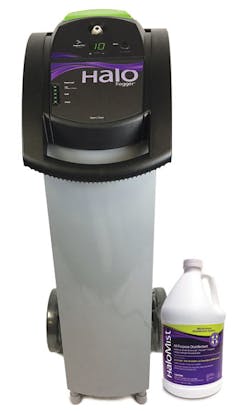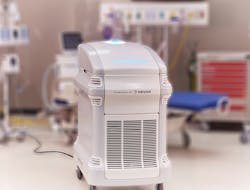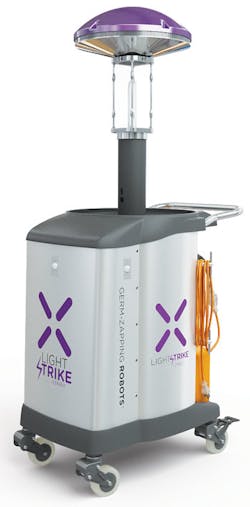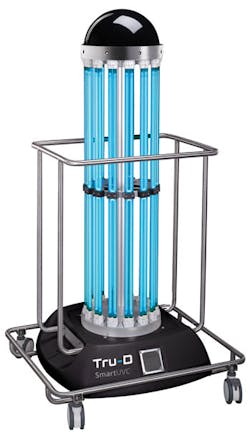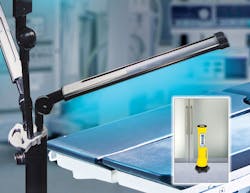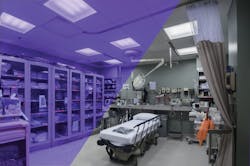Setting the stage for decontamination
Just like sterile processing professionals know how important it is to clean instruments before sterilization (if it’s not clean, it can’t be sterile) environmental service teams know how important it is to clean surfaces thoroughly before using their whole-room disinfection equipment, which more and more hospitals are including in their bundled approach to cleaning and disinfecting areas throughout the facility.
Dress rehearsal
Once that first critical cleaning step is completed, room disinfection machines — using ultraviolet emitters, xenon robots, chemical foggers, misters, atomizers, etc., — provide an extra layer of valuable protection. Research shows all types can make a significant impact on HAI reduction compared to cleaning alone. As for ultraviolet technologies, “The multitude of commercially-available devices makes choosing a device difficult,” wrote William A. Rutala, PhD, MPH, coauthor of a 2019 study. “UV devices may vary because of differences in UV wavelength, dose, ability to measure dose and cost. For these reasons, Infection Preventionists should review the peer-reviewed literature and choose for purchase only devices with demonstrated bactericidal capability as assessed by carrier test method and/or ability to disinfect actual rooms.”1
The adoption of these machines is catching on … sort of. According to Healthcare Purchasing News’ 2019 infection prevention (IP) survey results, many IP professionals said their facility uses some type of whole-room disinfection system, but just as many said no, they did not use such equipment. We also heard from a number of respondents who said their organizations were considering implementing a system. Cost and budget restraints are the most likely reasons hospitals are not making the purchase or still on the fence about it, Campbell said, and of course choosing which type of disinfection system is right for your facility is another factor that requires considerable thought and research.
What exactly should one keep in mind when shopping around? “Highest possible kill of all relevant organisms, simplicity, cost effectiveness, leaves no residue, patient and staff safety, speed of completion, and evidence to support claims,” is the list of factors that Campbell suggests value analysis teams should be thinking about when reviewing room disinfection products.
As for making the case to leadership about buying one, Campbell recommends submitting a detailed business proposal based on data and a cost analysis. “Data should include compliance to the bundle practices, PPE, hand hygiene, high-touch surface cleaning, EVS cleaning audits, and HAIs,” she said. “If compliance is low in these areas, focus should shift to increasing compliance prior to submitting the proposal. If or when compliance is high and HAIs have not been decreasing, provide data to support your proposal. Include the cost of the system and the cost of HAIs. Data helps drive change.” And here’s the best news: Since most systems offer a trial period, there’s no upfront costs or commitments to make which means you can take advantage of the opportunity to show and tell how room disinfection systems can drive down HAI rates and increase patient safety and satisfaction.
As for the many disinfectant products currently available, Healthcare Purchasing News reached out to a variety of different suppliers and asked them to give us their best pitch on what makes their products worth talking about. As expected, all were very passionate and dedicated to providing the best solution and each one also supported claims with research and case-study examples. Here’s some of what they said about the different types of modalities provided.
A mist sets the scene
“HaloMist, when dispensed by a HaloFogger, is EPA-validated to produce a 6-log kill (de-activation) of C. difficile spores in all the nooks and crannies of complex rooms. There can be no approved kill rate higher than 99.9999 percent, so the HDS (Halo Disinfection System) is one of a very small number of systems (one of four) to have that distinction in the U.S.,” asserted said David St.Clair, Chairman, CFO, Halosil International, Inc. “All four such systems are hydrogen peroxide-based, with two using an aerosol and two using hydrogen peroxide vapor. The EPA requires a 99.9999 percent kill rate against C. diff spores to allow any claim against them to be made, the name for which is “sporicidal.” Normally, to be classified as a disinfectant, a kill of at least 99.99 percent against vegetative bacteria and viruses is required. To be an EPA-registered “sanitizer,” a kill rate of 99.9 percent is generally the target.
“The HDS is a fraction of the capital cost — roughly 1/6th — of the other three EPA-approved systems, and between 1/4th to 1/12th the cost of any UV system known to us,” St. Clair said. “The bottom line for the Halo Disinfection System is that it is the most effective and most affordable whole-room disinfection system legally on the U.S. market (there may be illegal — i.e. not EPA-approved — chemical disinfection systems out there that also work, in spite of the significant liability risks they bring with them).”
Next up is Ed Striefsky, Vice President of Sales and Operations at Bioquell: “We have over 15 years’ experience and 55 scientific publications supporting the use of our technology in a wide range of settings and with proven outcomes reducing HAIs,” he said. “At Bioquell we use high quality 35 percent hydrogen peroxide to deliver a genuinely effective 6-log reduction to all parts of the target area, every time. Each Bioquell cycle can be independently validated by using Geobacillus stearothermophilus biological indicators, so not only is the equipment safe, small, fast, easy to use and regulatory compliant, but you can also be sure that it works. The important part of what you asked is in the wording ‘whole room disinfection.’ That is what Bioquell Hydrogen Peroxide Vapor technology offers. We are global leaders in providing this type of disinfection for the entire room, not just high touch areas, with the same level of efficacy throughout.
“Using a Bioquell system will ensure you only have to run a single cycle each time, with no need to move the system around the room, worry about ‘line of sight’ limitations or be concerned about the distance between the generator and the surface to be decontaminated. Bioquell’s products have been consistently proven to be effective against a wide range of target organisms, including bacteria, viruses and even resistant spores. Studies consistently show that manual cleaning alone will leave a high percentage of surfaces within a room contaminated, often over 50 percent. When combined with several extensive studies that show leading U.S. hospitals were able to reduce nosocomial infection by 39 percent to 60 percent while using Bioquell equipment, it starts to paint a picture of the potentially huge cost savings that can be achieved through successfully implementing Bioquell equipment or our in-house daily decontamination service called the Bioquell Proactive.”
Nevoa, Inc., hangs its hat on offering a patented, hospital-grade surface disinfecting system approved for atomizing an EPA-registered solution that contains the active ingredient Hypochlorous Acid (HOCl). “The system is comprised of two components. Nimbus — a machine that deploys (“atomizes”) a liquid solution into a hospital room to disinfect all surfaces and equipment, with no line-of-sight issues, and Microburst — an EPA-registered solution whose active ingredient is Hypochlorous Acid (HOCl),” asserted Ernest Cunningham, President, Nevoa, Inc. “Together, the Nimbus + Microburst system eradicates pathogens in patient rooms, lowering a patient’s risk of acquiring Healthcare Associated Infections (HAI), reducing hospital costs and improving the patient experience.
“A University of Arizona (U of A) study showed that Nevoa’s Nimbus + Microburst protocol resulted in average microbial log reduction of 4.68; and when combined with a modified manual cleaning protocol, the Nimbus + Microburst protocol using Hypochlorous Acid (HOCl) delivered a 300 times better kill rate than manual cleaning alone” Cunningham said. Additional results/features include “No microbial transfer, 64 percent improved labor efficiency; Microburst’s concentrations are much lower than bleach or peroxide. Approximate 28-minute turnaround time of patient room after discharge with 100 percent surface contact. Immediate re-entry into room, no waiting. No line-of-sight issues are experienced, as with some other protocols. It is effective against C. difficile, MRSA, VRE, Staph, Pseudomonas, and others.
“Nimbus + Microburst reaches all areas of a hospital room, even under the bed and behind equipment. Nimbus + Microburst HOCl solution is different from ultraviolet — it is EPA registered — ultraviolet modalities are not. It is German-engineered, including a smart device with custom reporting capabilities, it delivers 100 percent room surface contact via Microburst solution atomization, delivering up to 99.999 percent kill rate of HAI-causing pathogen. Nimbus + Microburst delivers a repeatable, consistent, whole room disinfection process, eliminating user error has a short cycle time versus peroxide systems, with rapid dehumidification technology built into the system for immediate room re-entry.”
Under the spotlight
Moving on to our ultraviolet and xenon disinfection suppliers, Xenex’s Vice President of Sales and Account Management, Irene Hahn, takes the stage first. “The most important factor to consider when evaluating disinfection technologies is whether the technology and associated protocols have demonstrated a repeatable positive impact on reducing infection rates. Can the vendor provide a list of multiple references from its client base that can attest to infection rate reductions that provided a positive return on investment? IPs should also look at the peer-reviewed, published outcome studies from hospitals who have deployed the technology. Were those reductions statistically significant?
Hospitals using LightStrike pulsed xenon UV disinfection technology usually report a quantifiable Return on Investment (ROI) as a result of fewer infections within a 6 to 9-month period. At Xenex, we’ve provided robots, customized protocols and training to a facility at no cost to prove that the technology is effective at helping them bring down infection rates. After a trial period, the hospital’s infection rates had fallen dramatically and they not only decided to invest in the technology but deployed robots at their other facilities and continue to report success. Xenex has worked closely with hospitals to maximize operational efficiencies so room turnover time is minimal. Adding LightStrike disinfection robots to the patient room turnover process requires less than 7 minutes when leveraging our best practices and recommended protocols. Xenex’s LightStrike robots work very quickly because they emit UV light across the entire germicidal spectrum. It is the intensity of light and broad spectrum of UV produced that kills pathogens where they are most vulnerable. This efficiency allows hospitals to disinfect exponentially more rooms per day (per robot) in order to truly bring down the bioburden within a facility.”
“Tru-D is clinically supported by more than 20 independent, peer-reviewed, journal-published studies including the Benefits of Enhanced Terminal Room-Disinfection (BETR-Disinfection) randomized clinical trial that showed that Tru-D was able to reduce the relative risk of colonization and infection caused by epidemiologically-important pathogens among patients admitted to the same room by a cumulative 30 percent in hospital settings with 93 percent compliance of standard disinfection protocols,” Dunn continued. “Individual hospital results may vary. Tru-D is the only UVC disinfection device with patented Sensor360 technology that measures the precise dose needed for complete room disinfection. Tru-D’s one placement positioning does not require the operator to move the device to multiple positions, leaving them free to complete other tasks during the disinfection cycle. Tru-D’s Sensor360 technology that compensates for room variables, such as size, shape and contents in the room, ensures thorough disinfection for each unique space. This unique, patented feature reduces human error in device placement and cycle time selection delivering a consistent and documented baseline of disinfection for all targeted at-risk rooms. With Tru-D, cycle times vary to provide consistent disinfection in various size rooms. Patient rooms typically require 15 to 25 minutes. The Tru-D disinfection program training provides efficiencies that demonstrated when compared to average overall room turn times there was only the four-minute overall variance.”
Larinda Becker, Healthcare Marketing, Diversey, said her company’s product, the MoonBeam3, “is fast, effective, portable and affordable. With 3- minute cycles, the 39-pound unit can be effectively deployed by any staff member. Its articulating arms enable the user to optimize dose coverage on both horizontal and vertical surfaces. MoonBeam can be easily moved around the facility and requires minimal storage space. The product cycle for the MoonBeam3 is 3 minutes. We recommend dosing two sides of the room and the bathroom for each patient room. In general, the system can be “doubled” up to run simultaneous cycles in the patient room and a cycle in the bathroom while the staff member is finishing the room. It is estimated that a patient room can be done in as little as 12 minutes with a single unit (includes placement of the device and cycle times) or in as little 7 minutes with two units.
“Most importantly, it can be acquired and operated at a fraction of the cost of other units,” Becker continued. “Operational leases (similar to renting), allow payments to be considered operational expenses, and allow the asset to stay off the balance sheet. In many cases, due to capital and time requirements, UV-C disinfection is being limited to a small sampling of rooms; however, with the recent launch of operational leases, requiring no capital expenditures and newer technologies that have faster cycle times and lower acquisition and use cost, UV-C can now be used more broadly across facilities. Increased deployment may also drive patient satisfaction by demonstrating a firm commitment to preventing infection. Programs are available for as little as $1000/month, and include the device, service and UV-C bulbs.
Gunner Lyslo, Founder and CEO, Surfacide, said his technology “addresses the role of shadows given our multiple emitter approach. Published data indicate that UV is a direct line of sight technology. When using three emitters during a single treatment cycle, most surfaces are within the direct line of sight and effectively treated. Single emitter systems should require frequent repositioning and extended run times. Surfacide’s automated system provides shorter cycle times and increased staff productivity without repositioning.
Lyslo said most rooms can be treated within 15 minutes with the Surfacide technology. “ORs take slightly longer given they are larger,” he said. “It is for this reason that these low five-minute disinfection cycles are simply not possible and defy the laws of physics. NO patient signs up for an infection while seeking care and patients expect to receive the highest level of care within the hospital. We believe that Surfacide collaborates with our healthcare customers to provide that.”
Unlike the ultraviolet disinfection solutions discussed above, continuous, all-day LED versions that are safe for human exposure are also available.
“The biggest value-add that Vital Vio’s proprietary antibacterial LED lighting technology brings (and what differentiates us from other hospital decontamination methods) is that our process is continuous versus intermittent,” explained Kristin May, Chief Commercial Operations Officer at Vital Vio. “Other solutions on the market, such as ultraviolet light (UV), which is not safe for human exposure, is only able to provide what is known as a “terminal” clean, which sanitizes spaces once patients and staff are no longer using the room. In between these cleanings, bacteria can easily form and spread, leaving patients, doctors and visitors at risk until the next wave of disinfection. While UV light is extremely powerful, it’s also especially dangerous to humans, directly impacting the DNA in people, animals and plants, along with bacterial cells.
“Alternatively, by adopting a continuous disinfection approach, health systems can protect against HAIs in a way that isn’t potentially harmful to patients and doctors. In Vital Vio’s case, we insert bacteria-killing, visible LED lighting that can be used 24/7/365 — both with overhead lighting in large environments, and within smaller spaces like consumer appliances,” May continued. “This creates a multi-layered germ defense system that not only disinfects, but maintains disinfection, preventing the regeneration and spread of germs.”
Reference
1. Rutala, W., et al (2019). Best practices for disinfection of noncritical environmental surfaces and equipment in health care facilities: A bundle approach. American Journal of Infection Control. (47) A96−A105
About the Author

Valerie J. Dimond
Managing Editor
Valerie J. Dimond was previously Managing Editor of Healthcare Purchasing News.


